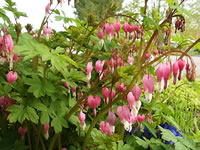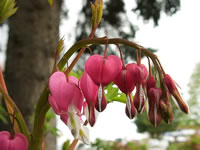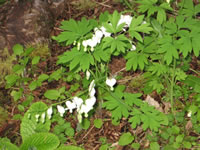How to Grow and Care for Bleeding Heart Plants
Dicentra spectabilis
          
The Bleeding Heart is an extremely cold-hardy (USDA zones 3-9), mounding plant with finely cut,
fern-like foliage on graceful 2-3 foot arching stems topped with pretty, heart shaped, 1" flowers.
Bleeding Hearts produce their blooms in late spring or early summer,
then they may die back entirely, and remain dormant until the following spring.
Dicentras are excellent plants for any shade garden or woodland setting
and are ideal for planting among your Ferns, Primroses, and Hostas.
Growing Requirements for Bleeding Heart Plants
|

|
Bleeding Hearts thrive in moist, humusy rich, well-drained soil in partial to full shade.
In cooler climates, Bleeding Hearts will tolerate full sun if they are given enough moisture.
In warm climates, they must be provided with partial to full shade.
Dicentra spectabilis plants will tolerate slightly alkaline soil.
Add lots of compost, humus, or peat moss to the soil at planting time
to enhance its water retention capabilities.
Plant Bleeding Heart roots 2 feet apart, as soon as they become available in the spring.
Mulch the soil surrounding Dicentras plant in the fall and again in the spring
using compost, leaf mold or garden litter.
Provide protection from high winds and early frosts.
Bleeding Hearts will not tolerate wet soil in winter and dry soil in summer.
Water regularly and thoroughly during the growing season. |
|
|
Dividing and Transplanting Bleeding Hearts
Bleeding Hearts last for years and will probably become overcrowded and need dividing every 3-4 years.
Transplanting can be done in late autumn or winter.
Large Bleeding Hearts can have an enormous system of thick, fleshy roots.
Take extra care not to damage these brittle roots and to keep the entire root ball intact when transplanting.
Propagating Bleeding Heart Plants
New Dicentra plants can be propagated by 3-6" root cuttings
which can be taken in the spring or fall.
Bleeding Heart seeds should be sown while they are fresh.
If your winter season includes 6-8 weeks of freezing weather, you can sow seeds of Dicentra spectabilis directly into your garden in the late fall.
The seeds will germinate during the following spring.
To start Bleeding Heart seeds indoors, sow fresh seeds in a
moistened growing medium, then freeze them for six weeks.
After the freezing period, move them to an area where you can maintain
a temperature in the growing medium of 55°-60° until germination,
which takes anywhere from 30-50 days. |
|
Bleeding Hearts
Dicentra spectabilis

|

|

|
|
|
|
Search The Garden Helper:



